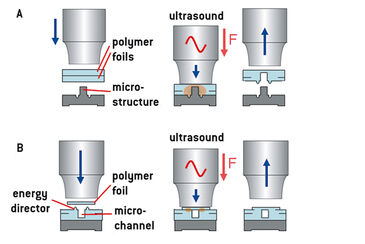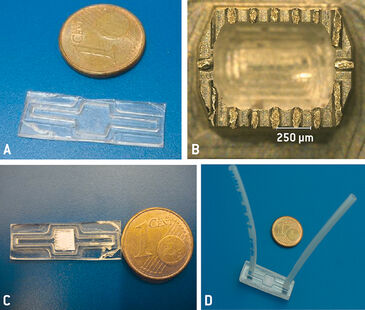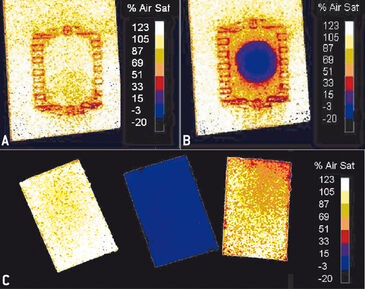Watch tutorials, webinars and informative videos about PreSens optical sensor systems.
Integration of Oxygen Sensor Foils in Microfluidic Chips
Applicability of VisiSens in Micro-Channels made by Ultrasonic Welding

L. Burs, A. Witte, J. Wlodarczyk, T. Nieradzik, W. K. Schomburg
Faculty of Mechanical Engineering, KEmikro, RWTH-Aachen University, Germany
We evaluated the VisiSens™ A1 imaging system for its applicability in micro-channels to create a microfluidic chip with integrated oxygen sensing. The experiments described here focus on the manufacturing of micro-channels by ultrasonic hot embossing and welding, and the integration of oxygen sensor foils in these channels, either by ultrasonic welding or using non-fluorescent glue. Several methods were tried for ultrasonic welding of the sensor foil. We found that a frame-shaped tool is suited best for welding the sensor foil into a micro-channel. Along the welding seam the oxygen sensing capability of the sensor foil is impaired, but the area inside the frame shows the expected oxygen values, as we determined in following tests. We also verified that the sensor foil glued in the micro-channel shows correct oxygen readings. Further tests need to be performed, but first results show that VisiSens™ is a suitable tool for oxygen monitoring in Lab-on-a-Chip systems.

With microsystems technology chemical laboratories can be miniaturized down to micro-scale. These Lab-on-a-Chip systems consist of a micro-channel system that can be used for chemical or biological analysis. As these microfluidic chips are very small and portable they can be applied anywhere. Only small drops of sample fluids are needed, which is resource-efficient, and speeds up reaction and analysis times. Microfluidic chips used in this study have been made by an ultrasonic hot embossing and welding process developed at the KEmikro. Aim of this study was to test the applicability of the VisiSens™ A1 imaging system in such microfluidic chips. As this system allows 2-dimensional recording of oxygen distributions with high spatial resolution, it does not alter the tested fluids, and its oxygen sensing capability is independent from the flow rate of liquids, it might be a suitable solution for Lab-on-a-Chip systems. The oxygen sensor foils had to be integrated in micro-channels created by ultrasonic hot embossing. For integration either non-fluorescent glue or ultrasonic welding were used. Several experiments were performed in order to determine whether these methods of integration would impair the sensor foil, and if a microfluidic chip with integrated oxygen sensing could be created.
Creating Micro-Channel Systems by Ultrasonic Hot Embossing and Welding
This process is performed with a commercially available ultrasonic welding device. Several polymer foils are put between a special mould, showing the negative shape of the chip (micro-structure), and a sonotrode (Fig. 1A). When applying ultrasonic pulses friction is created; this melts the polymer foils in the area in which they are in contact with the sonotrode and the mould. Only the part of the foils which should be shaped is melted, and with a process time of only about 2 seconds this method of creating a micro-channel is very fast. The so-called energy directors at the upper edge of the micro-channel are necessary for closing the channel with a lid by welding (Fig. 1B).
The microfluidic chips used in these experiments were made of the same material as the oxygen sensor foil is based on. This is important for sensor integration by ultrasonic welding, as both the sensor foil and the channel need to have the same melting point. Two chips have been created; the shape of the micro-channel welded into the polymer foil is depicted in Fig. 2A. This shape was chosen so there was enough space for integrating the sensor foil. In the first microfluidic chip the sensor foil was attached by ultrasonic welding with a frame-shaped tool (Fig. 2B + C). Preliminary tests had shown, that this is the best method for welding the sensor into the micro-channel. Silicone Rubber Compound - Flowable Fluid (RS Components Ltd.) was used for gluing the sensor foil in the channel of the second chip. The glue needed to cure for about 15 minutes, however several days of curing were needed before full strain could be put on it. After the sensor foils were attached inside the micro-channels, a lid of 4 mm thickness with two holes for liquid supply was welded on each microfluidic chip (Fig. 2D).
A Micro-Channel with Integrated Oxygen Measurement
In order to evaluate, if the VisiSens™ A1 system is suitable for oxygen measurement in Lab-on-a-Chip applications, the oxygen content of air, water, and sodium sulfite solution (1%) was measured in the created microfluidic chips. The detector unit was set up as is shown in Fig. 3; a box was used to block ambient light during oxygen imaging. A first image was taken of the sensor foil, which had been welded into the micro-channel, in ambient air. The area of the welding seam (frame-shape) showed oxygen concentrations between 33 - 51 % air sat. (Fig. 4A). There the measured oxygen concentration was about 50 % lower than on the rest of the sensor foil. So the oxygen sensitive layer is impaired in the area of the welding seam. However, the rest of the sensor foil showed the expected oxygen values, as could be verified when applying a drop of sodium sulfite solution (Fig. 4B). Testing the microfluidic chips with the glued sensor foil, first water, then sodium sulfite solution (1%) and again water was used for measurements. The different oxygen concentrations could be clearly detected with the foil glued to the channel, as can be seen in Fig. 4C.
Conclusion
These first results show that VisiSens™ A1 is a suitable tool for oxygen measurements in Lab-on-a-Chip systems. This combination of microfluidic chips and VisiSens™ can be used to analyse certain reactions. We found that gluing as well as welding with a frame-shaped tool can be used to integrate the oxygen sensor foil in a micro-channel. Further tests should be performed to determine whether welding might be a more economic solution as it only takes a few seconds compared to long curing times when glue is used. On the other hand, when attaching the sensor foil with glue different and more appropriate materials could be used for the microfluidic chip itself.
Application Note adapted from
L. Burs et al., KEmikro, RWTH-Aachen University, Project Report: Fertigung mikrooptischer Sensoren im Ultraschallheißprägeprozess mit laserpolierten Werkzeugen




